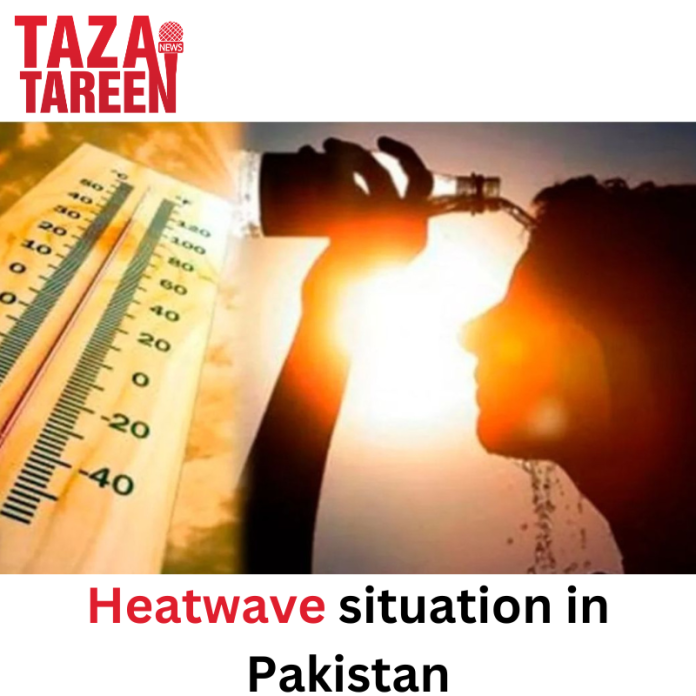Pakistan is grappling with one of the most intense heatwaves recently, this heatwave continues to sweep across the country. The heatwave points out the urgent need for climate resilience in Pakistan. It is important to protect the citizens and to work on infrastructure of Pakistan. That includes better cooling system in home and public places, work on green spaces, and work on water conservation measures. Moreover, addressing the main issue of climate change with the help of sustainable practices and international cooperation to reduce the intensity of heatwave.
Record-Breaking Temperature
Pakistan Meteorological Department (PMD) reported a national mean maximum temperature of 38.33°C, which is 2.07°C above the long-term average. Pakistan Tightens the Belt as Severe Heat Continues Amidst Respite. Pakistanis suffer from the fourth, long-sustained heat wave that has been affecting the country since early May. The PMD warned about dry heat of 40°C (104°F) or more over fluctuating parts of the country, with even day-to-day temperatures reaching 3-5°C (5-9°F) above normal.
- Khyber Pakhtunkhwa Province is experiencing marginally less extreme temperatures, however, it is no different than the overall intensity of the heatwave which has put at stake resources and as well as health concerns for the country in whole.
Impact of the Heatwave:
The heatwave brings unhealthy levels of energy use as many people started to increase their home temperatures by using their air conditioners. Besides, the fact also results in a power disruption in some regions. Water consumption has increased too over and above the existing shortages of this most important resource. The most poorest people, of course, children, elderly individuals, and those who have illnesses, the risk of heatstrokes and dehydration are already high. It has been easier for medical centers to confirm the fact of the abundance of heat issues among people.
Hope for Relief
Not losing all of the hope the end of the tunnel is in sight. PMD predicts that the weather system that would be carrying showers, storms, and winds with high intensity would make its way into the western part of the country from 10th May onwards. This process will also be distributed across the country starting with much needed relieving temperatures and then evenly cooling off the country.
Awareness is Key
NDMA has heatwave guidelines promulgating the public into drinking enough water. They suggests not doing intensive task during sunny hours and wearing something loose and distinctive. The NDMU stated that it is necessary to ensure on those neighbors and loved ones who are at risk. However, the ongoing heatwave may be about to subside , but it is a reminder of the serious challenges Pakistan currently faces due to increasing temperature conditions. In the long run, strengthening of long-term measures, like- ease of access to clean water and more trees in urban areas will stand us in good stead as a country.
The PMD (Pakistan Meteorological Department) did forecast a heat advisory for May 2024 with temperature being above normal by 3-5°C (5-9°F) in most parts of the country, including Lahore and Karachi. The temperature was predicted to remain high until late May, with the prevailing of pre-monsoon rains bringing the much awaited coolness.
Strain on Energy and Water Resources
The heatwave has significantly increased electricity demand due to widespread use of air conditioning and cooling systems. It is leading to power outages in several regions. Additionally, water consumption has surged, exacerbating existing water shortages and putting further stress on the country’s water resources.
The Need for Climate-Resilient Infrastructure
The recurring heatwaves highlight the necessity for Pakistan to invest in climate-resilient infrastructure, including:
-
Urban Green Spaces: Planting trees and developing parks to mitigate the urban heat island effect.
-
Water Conservation Measures: Implementing efficient water management systems to address shortages.
-
Improved Cooling Systems: Enhancing access to affordable and sustainable cooling solutions in homes and public spaces.
How to Stay Safe During Extreme Heat
1. Stay Hydrated at All Times
Drink plenty of water even if you’re not thirsty. Avoid sugary, caffeinated, and alcoholic drinks as they can dehydrate you faster. Always carry a water bottle if you’re stepping outside.
2. Avoid Going Out in Peak Heat Hours (11 AM to 4 PM)
Schedule errands or outdoor work early in the morning or after sunset. If you must go out during the day, take frequent breaks in shaded or air-conditioned areas.
3. Wear Light, Loose-Fitting Clothing
Choose light-colored, breathable fabrics like cotton. Avoid dark, tight, or synthetic clothing, as it traps heat and raises your body temperature.
4. Use Sunscreen and Wear a Hat
Protect your skin from direct sunlight by applying SPF 30+ sunscreen. Wearing a wide-brimmed hat or carrying an umbrella can provide extra protection.
5. Keep Your Home Cool
Use fans, curtains, and cross-ventilation to reduce indoor heat. Avoid using the oven or stove during the day. If available, use air conditioning efficiently but avoid overloading electricity.
6. Watch Over Vulnerable Family Members
Check regularly on infants, older adults, and those with medical conditions. Ensure they are staying cool, hydrated, and not overexerting themselves.
7. Take Cool Showers or Sponge Baths
This can help regulate body temperature when it gets too high. Apply a wet towel or cold compress to your forehead, wrists, and neck for quick relief.
8. Eat Light and Fresh Meals
Avoid heavy, oily meals during the heatwave. Fresh fruits and vegetables with high water content like watermelon, cucumbers, and oranges are ideal.
9. Recognize Warning Signs of Heat Illness
Watch out for symptoms like dizziness, rapid heartbeat, confusion, nausea, or headache. These could be signs of heat exhaustion or heatstroke, which require immediate medical help.
10. Follow NDMA and PMD Alerts
Stay informed through local media, official heatwave advisories, and SMS alerts from NDMA. Respond accordingly to any emergency instructions or forecasts.
Wake-Up Call
The ongoing heatwave serves as a stark reminder of the challenges posed by climate change. It is imperative for Pakistan to implement long-term strategies focused on sustainable development, infrastructure resilience, and public awareness to safeguard its citizens against future climate extremes.
Let us know, if you find this article helpful!


